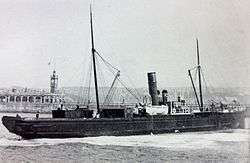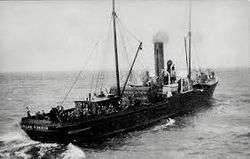SS Ellan Vannin (1883)
| RMS Mona's Isle | |
| History | |
|---|---|
| Name: | Mona's Isle |
| Owner: | Isle of Man Steam Packet Company |
| Operator: | IoMSPCo |
| Port of registry: |
|
| Route: | Various |
| Builder: | Tod & McGregor Ltd. Meadowside, Glasgow |
| Cost: | £10,673 |
| Launched: | 10 April 1860 |
| Completed: | 1860 |
| Reclassified: | 1883 |
| Homeport: | Ramsey |
| Identification: | Official Number 27260. |
| Fate: | 1883: converted to screw-driven vessel |
| General characteristics as Mona's Isle | |
| Type: | Paddle steamer |
| Tonnage: | 339 GT |
| Length: | 198 ft 6 in (60.5 m) |
| Beam: | 22 ft 2 in (6.8 m) |
| Depth: | 10 ft 7 in (3.2 m) |
| Installed power: | oscillating engines, manufactured by Tod and McGregor Ltd |
| Propulsion: | Side paddles |
| Speed: | 12 knots (22 km/h; 14 mph) |
| Crew: | 14 |
| Ellan Vannin | |
| Name: | Ellan Vannin |
| Namesake: | the Manx name for the Isle of Man |
| Renamed: | 16 November 1883 |
| Identification: |
|
| Nickname(s): | "The Li'l Daisy"[2] "The Vannin" |
| Fate: | 3 December 1909: sank in a storm between the Bar Lightship and the Q1 Buoy, River Mersey 53°32′00″N 03°17′00″W / 53.53333°N 3.28333°W |
| General characteristics as Ellan Vannin | |
| Type: | Packet Steamer |
| Tonnage: | 375 GT |
| Installed power: | two-cylinder compound steam engine made by Westray, Copeland and Co. |
| Propulsion: |
|
| Speed: | 12.5 knots (23 km/h) |
| Capacity: | 299 passengers: 134 first class, 165 third class. Cabin capacity for 28 passengers (first class) and 25 (third class). |
| Crew: | 21 |
SS (RMS) Ellan Vannin (the Manx name for the Isle of Man) was built as an iron paddle steamer in 1860 at Meadowside, Glasgow for the Isle of Man Steam Packet Company. She was originally named Mona's Isle - the second ship in the Company's history to be so named. She served for 23 years under that name before being rebuilt, re-engined and renamed in 1883. As Ellan Vannin she served for a further 26 years before being lost in a storm on 3 December 1909 in Liverpool Bay.
Mona's Isle
Mona's Isle was built by Tod and McGregor Ltd, Glasgow, at a cost of £10,673. She entered service with the Steam Packet Fleet in June 1860.
Mona's Isle is important in the history of the line, as she was the first vessel to be fitted with oscillating engines, which were also manufactured by Tod and McGregor Ltd. Until 1860 the Company had always used the side-lever engine so favoured by Robert Napier & Co. The oscillating engines possessed a number of advantages over the side-lever, as it occupied less space and had fewer working parts. A further enhancement was the addition of improved feathering floats which were fitted to the paddle wheels.
There was no requirement for a connecting rod, and the upper end of the piston rod was fitted with a bearing which worked directly on to the crankpin. The cylinder was placed vertically under the crankshaft and could pivot through a small arc, permitting the rod to follow the movement of the crank.
When launched, Mona's Isle had a registered tonnage of 339 tonnes (GRT), and with 600 ihp (450 kW). This gave her a speed of approximately 12 knots.
After 23 years service, Mona's Isle was laid up at Ramsey and subsequently was taken under tow to Barrow by the Fenella in order to undergo her rebuild, on Friday 19 January 1883.[3]
Ellan Vannin
Rebuilt in 1883, her weight was increased to 375 tonnes and her speed to 12.5 knots (23.2 km/h). She was renamed Ellan Vannin (the Manx translation for Mona's Isle) on 16 November 1883, following her conversion to a propeller-driven ship. Ellan Vannin was a twin-screw vessel driven by a two-cylinder compound steam engine made by Westray, Copeland and Co. at Barrow. Her boiler pressure was raised to 80 pounds per square inch (550 kPa).
She was capable of carrying 300 passengers and normally had a crew of 14. Ellan Vannin primarily operated out of Ramsey to Whitehaven, Liverpool and Scotland. She gave 26 years more service, and became the main mail carrier out of Ramsey. In December 1891, she completed a special overhaul at the Naval Construction Works at Barrow, costing £2,913.
By 1909 she was the smallest and oldest ship in the Steam Packet Fleet. Ellan Vannin was considered an exceptionally fine vessel in bad weather, carrying out the daily mail contract when other vessels were safe in harbour.
Indeed, stormy weather appeared to be no deterrent to her, and it is reported that when up to 12 ocean liners had been taking shelter in Ramsey Bay, Ellan Vannin steamed through them as she made passage to Whitehaven and returned in the evening, the completion of her voyage being heralded by the ships sheltering in the bay sounding their whistles.[2]
Ellan Vannin became looked upon as a mascot of the Steam Packet fleet,[2] and known by Manx sailors as the Li'l Daisy.
Loss
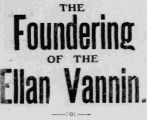
On 3 December 1909, Ellan Vannin left her home port of Ramsey at 01:13hrs, under the command of her Master, 37 year old Captain James Teare, who had some 18 years of experience working his way through the company to the position of Master.[4] During the summer of 1909 Teare was in command of the King Orry[4] and had only joined the Ellan Vannin the day before her ill-fated voyage.[4] Captain Teare was married with four children.[4]
Ellan Vannin was carrying 15 passengers and 21 crew as well as mail and 60 tonnes of cargo which included approximately 60 sheep.
The weather on departure was moderate and although the barometric pressure was falling the captain did not expect a significant deterioration in the weather. The wind direction on departure was from the northwest meaning the Ellan Vannin would have a following sea during her passage - something which would have caused her master no particular concern.[4] However, the weather rapidly worsened and by 06:35hrs, when the ship arrived at the Mersey Bar lightship, the wind had risen to a Hurricane Force 12, and waves were reported to be exceeding 24 feet (7 m) in height.[2]
A strong consensus at the time[4] was that with a following sea the Ellan Vannin had made good time to the Bar Lightship.[4] Upon reaching the Bar her course would have been changed from approximately 130 degrees to 080 degrees as she entered the approach channel to the river. This would have caused her to take the sea on her port beam with the result that she got sufficiently off her course to strike a sandbank[4] thereby causing her to founder, (a nautical term for filling with water and sinking), between the Bar lightship and the Q1 buoy sinking in the Mersey approach channel (at 53°32′0″N 3°17′0″W / 53.53333°N 3.28333°W).[5] It is believed she was broached by a large wave, which overwhelmed the ship. She was swept by heavy seas and filled, sinking by the stern with the loss of all passengers and crew.
News of the disaster reached Douglas on the Friday evening, and the directors sat in almost continuous session until Monday. Communication was by telegram and information was difficult to ascertain.
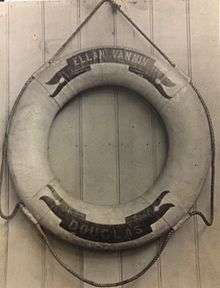
At approximately 19:00hrs[4] a telegram was received which reported that the crew of the Formby Lightship had seen lifebuoys, bags of turnips, several dead sheep and a piano floating near the lightship.[4] It was also reported that the crew of the lightship had picked up a mail bag which was destined for the Birkenhead Post Office and which was found to contain letters despatched from Ramsey.[4]
The following morning the company offices in Douglas received a telegram from Liverpool stating that one of the Ellan Vannin's lifeboats had been washed ashore at New Brighton with its cover on and its working gear inside.[4] Also washed ashore were parts of the ship's bridge.[4]
On Saturday morning Tynwald departed Douglas in order to replace the Fenella on the Douglas - Liverpool service, with the Fenella in turn taking the sailing to Ramsey which should have been undertaken by the Ellan Vannin.[4]
It was five days after the ship went down that the first bodies were recovered. In January 1910, Teare's body was found washed ashore on Ainsdale beach in Southport. It was subsequently returned to the Isle of Man for burial.
Aftermath
The Board of Trade inquiry found that the captain was not to blame for the disaster and the cause was extreme weather. The official inquiry referred to waves 24 feet (7 m) high and declared the ship to have been in good condition and fully seaworthy. After the foundering, her masts broke the surface. Divers inspecting the ship found damage to the bows and that the lifeboat davits had been swung out ready for lowering. Soon after the disaster the Mersey Docks and Harbour Board destroyed the wreck using explosives, as it was causing a hazard to shipping in the channel.
A disaster fund was established for those who were dependants of the deceased, the Steam Packet contributed £1,000 to this fund. The crew of 21 included one woman, a Mrs. Callister, of Crosby, Isle of Man, who left one child. The 20 men were survived by 18 widows and 70 children. All but two of the crew lived on the Isle of Man. Five of the passengers came from off Island, the rest from the north of the Island. The last beneficiary of the fund was a Miss Benson of Ramsey, the daughter of one of the crew. She was 20 at the time of the disaster and was in very poor health. It was most unlikely that she would be the last to benefit from the fund, but she was, dying in 1974 at the age of 85.
Although the Isle of Man Steam Packet Company has a tradition of reusing ship names, they have never reused the name Ellan Vannin.
A song written by Hughie Jones of The Spinners commemorates the disaster.
Victims
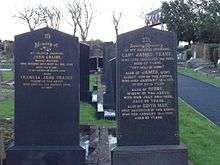
Crew
Second in command to Capt. Teare was 45 year old First Officer John Craine of Leigh Terrace, Douglas, who like Capt. Teare had worked his way up through the company. During the previous summer Craine had served on the Mona. Second Officer was John Kinley of Surby, Port Erin, who had previously served on the Fenella. William Kelly, of Mill St, Castletown, although sailing as deck crew was a Licensed mariner who had served as Second Officer on the Tynwald during the summer. Kelly's brother was also in the employ of the Isle of Man Steam Packet Company and was also serving on the Ellan Vannin leaving the ship only a day or so before the sailing.[6]
| Name | Position | Place of residence |
|---|---|---|
| Teare, Capt. James | Captain | York Rd, Douglas, Isle of Man.[4] |
| Craine, Mr. John | First Officer | Leigh Terrace, Douglas, Isle of Man.[4] |
| Kinley, Mr. John Thomas | Second Officer | Surby, Port Erin, Isle of Man.[4] |
| Bellis, Mr. Edward | Chief Engineer | Dyson Street, Walton, Liverpool.[4] |
| Craine, Mr. Frederick | Second Engineer | Laureston Road, Douglas, Isle of Man.[4] |
| Cannell, Mr. Walter | Fireman | Onchan, Isle of Man.[4] |
| Crellin, Mr. Joseph | Fireman | Glen Vine, Marown, Isle of Man.[4] |
| Shimmin, Mr. William | Fireman | Ramsey, Isle of Man.[4] |
| Taubman, Mr. John, Clegg | Fireman | Big Well St, Douglas, Isle of Man.[4] |
| Rydings, Mr. Servetus | Donkeyman | South Quay, Douglas, Isle of Man.[4] |
| Cunningham, Mr. James Shepherd | Carpenter | Mona Terrace, Douglas, Isle of Man.[4] |
| Cook, Mr. John William | Able Seaman | Peel, Isle of Man.[4] |
| Benson, Mr. John | Seaman | Ramsey, Isle of Man.[4] |
| Clague, Mr. Richard Alfred | Seaman | Barrack St, Douglas, Isle of Man.[4] |
| Crawley, Mr. James Lambert | Seaman | Bucks Rd, Douglas, Isle of Man.[4] |
| Corkish, Mr. Thomas | Seaman | Ramsey, Isle of Man.[4] |
| Kelly, Mr. William | Seaman | Mill St, Castletown, Isle of Man.[4] |
| Burke, Mr. Edward | Ship's Cook | Derby Rd, Douglas, Isle of Man.[4] |
| Stubbs, Mr. Thomas | Chief Steward | Liverpool.[4] |
| Holland, Mr. Herbert Holden | Second Steward | Head Rd, Douglas, Isle of Man.[4] |
| Collister, Mrs. Eliza | Stewardess | Crosby, Isle of Man.[4] |
Passengers
Of the passengers on board, two were leaving the Isle of Man for business overseas. Mark Joughin of Ballawhannell, Bride, Isle of Man, was on his way to America to make enquiries into an estate which had been left to him.[4] Another passenger was Edgar Blevin of the accountancy firm Kerruish, Son & Blevin of Douglas and Liverpool, whilst Christopher Heaton-Johnson of Beaconsfield Towers, Ramsey, Isle of Man, was en route to India.[4] Thomas Quayle of Andreas, Isle of Man was a former steward for the Archdeacon of Sodor and Man, he was on his way to Liverpool in order to undergo an operation. He left a widow and three children.[7] Two of the passengers, Daniel Newell of Croydon, Surrey, and Walter Williams of Earl's Court, London, were engaged in carrying out stone work on the Catholic church, Ramsey, Isle of Man.[4]
| Name | Age | Place of residence |
|---|---|---|
| Mrs. Mary Allen | 42 | |
| Mstr. Earnest Allen | 15 | |
| Mr. Edgar John Blevin | - | Vaughn Rd, New Brighton, Cheshire.[8] |
| Mrs. Amy Crix | 22 | College St, Ramsey, Isle of Man.[4] |
| Miss Mary-Ann Crix | 10 months | College St, Ramsey, Isle of Man.[4] |
| Miss. Louis Findlay | 24 | Grange Hill Rd, Eltham, Kent.[8] |
| Miss. Eleanor Fisher | 30 | Queen's Hotel, Ramsey, Isle of Man.[4] |
| Mr. Christopher Thomas Heaton-Johnson | 35 | Beaconsfield Towers, Ramsey, Isle of Man.[4] |
| Mrs. Heaton-Johnson | - | Beaconsfield Towers, Ramsey, Isle of Man.[4] |
| Mr. William Edward Higginbottom | - | Trafalgar Hotel, Ramsey, Isle of Man.[4] |
| Mr. Mark Henry Joughin | - | Ballawhannell, Bride, Isle of Man.[4] |
| Mr. Daniel Newell | - | Hampton Rd, Croydon, Surrey.[4] |
| Mr. Thomas Henry Quayle | - | Andreas, Isle of Man.[7] |
| Mr. Walter Williams | - | Earl's Court Rd, London.[4] |
Gallery
| RMS Ellan Vannin | ||||||
|---|---|---|---|---|---|---|
|
References
Notes
- ↑ Ships of the Isle of Man Steam Packet Company (Fred Henry) p.64
- 1 2 3 4 Ships of the Isle of Man Steam Packet Company (Fred Henry, 1973) p.10
- ↑ The Isle of Man Examiner. Saturday 20 January 1883.
- 1 2 3 4 5 6 7 8 9 10 11 12 13 14 15 16 17 18 19 20 21 22 23 24 25 26 27 28 29 30 31 32 33 34 35 36 37 38 39 40 41 42 43 44 45 46 47 The Isle of Man Examiner. December 4th, 1909, (p.9)
- ↑ "SS Ellan Vannin [+1909]". Wreck site. Retrieved 6 October 2013. (registration required (help)).
- ↑ Isle of Man Examiner. Saturday December 11th, 1909 (p.6).
- 1 2 Mona's Herald. Wednesday, January 19th, 1910 (p.7).
- 1 2 Mona's Herald. Wednesday January 26th, 1910 (p.5).
Bibliography
External links
| Wikimedia Commons has media related to Ellan Vannin. |
- Isle of Man disasters
- "The loss of the Ellan Vannin"
- Video of Hughie Jones' Song "Ellan Vannin" - performed as part of the Irish Sea Sessions 2012 at Liverpool Philharmonic Hall
- "Video of Hughie Jones' Song 'Ellan Vannin Tragedy' - performed by Stationary Willberries from the Isle of Man (with permission of H.Jones)"
